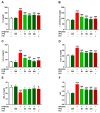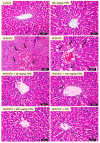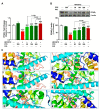Consumption of Terpenoids-Rich Padina pavonia Extract Attenuates Hyperglycemia, Insulin Resistance and Oxidative Stress, and Upregulates PPARγ in a Rat Model of Type 2 Diabetes
- PMID: 31887984
- PMCID: PMC7022299
- DOI: 10.3390/antiox9010022
Consumption of Terpenoids-Rich Padina pavonia Extract Attenuates Hyperglycemia, Insulin Resistance and Oxidative Stress, and Upregulates PPARγ in a Rat Model of Type 2 Diabetes
Abstract
Seaweeds are rich in structurally diverse bioactive compounds with promising therapeutic effects. This study aimed to isolate and identify terpenes from the brown alga Padina pavonia and to investigate its antidiabetic activity, pointing to the possible involvement of peroxisome proliferator-activated receptor (PPAR)γ. Type 2 diabetes was induced by feeding rats a high fat diet (HFD) for 4 weeks followed by injection of 35 mg/kg streptozotocin (STZ). The diabetic rats received P. pavonia extract (PPE; 50, 100 and 200 mg/kg) for 4 weeks and samples were collected for analyses. HFD/STZ-induced rats showed hyperglycemia, dyslipidemia, impaired glucose tolerance, decreased insulin, and increased HbA1c and HOMA-IR. PPE ameliorated hyperglycemia and dyslipidemia, and improved glucose tolerance and insulin sensitivity in diabetic rats. Treatment with PPE increased hepatic hexokinase activity and glycogen, suppressed glucose-6-phosphatase, fructose-1,6-biphosphatase, and glycogen phosphorylase, and attenuated oxidative stress, inflammation, and liver injury and lipid infiltration in HFD/STZ-induced rats. In addition, PPE boosted antioxidants and upregulated PPARγ gene and protein expression in the liver of diabetic rats. Phytochemical investigation resulted in the isolation of six terpenes from PPE and in silico analysis revealed their binding affinity toward PPARγ. In conclusion, P. pavonia-derived terpenes attenuated hyperglycemia, dyslipidemia, oxidative stress, and inflammation, and improved insulin sensitivity and carbohydrate metabolism in type 2 diabetic rats. These beneficial effects are mediated via PPARγ activation. However, further studies to explore the exact mechanisms underlying the antidiabetic effect of PPE are recommended.
Keywords: PPARs; diabetes; oxidative stress; seaweeds; terpenes.
Conflict of interest statement
The authors declare no conflict of interest.
Figures










Similar articles
-
A flavonoid-rich fraction of Euphorbia peplus attenuates hyperglycemia, insulin resistance, and oxidative stress in a type 2 diabetes rat model.Front Pharmacol. 2023 Jun 16;14:1204641. doi: 10.3389/fphar.2023.1204641. eCollection 2023. Front Pharmacol. 2023. PMID: 37397470 Free PMC article.
-
Arbutin ameliorates hyperglycemia, dyslipidemia and oxidative stress and modulates adipocytokines and PPARγ in high-fat diet/streptozotocin-induced diabetic rats.Life Sci. 2023 May 15;321:121612. doi: 10.1016/j.lfs.2023.121612. Epub 2023 Mar 21. Life Sci. 2023. PMID: 36948387
-
Antidiabetic Effect of Monolluma quadrangula Is Mediated via Modulation of Glucose Metabolizing Enzymes, Antioxidant Defenses, and Adiponectin in Type 2 Diabetic Rats.Oxid Med Cell Longev. 2019 Feb 19;2019:6290143. doi: 10.1155/2019/6290143. eCollection 2019. Oxid Med Cell Longev. 2019. PMID: 30915195 Free PMC article.
-
Rumex dentatus L. phenolics ameliorate hyperglycemia by modulating hepatic key enzymes of carbohydrate metabolism, oxidative stress and PPARγ in diabetic rats.Food Chem Toxicol. 2020 Apr;138:111202. doi: 10.1016/j.fct.2020.111202. Epub 2020 Feb 19. Food Chem Toxicol. 2020. PMID: 32084495
-
Brown seaweeds protect against azoxymethane-induced hepatic repercussions through up-regulation of peroxisome proliferator-activated receptor gamma and attenuation of oxidative stress.Pharm Biol. 2016 Nov;54(11):2496-2504. doi: 10.3109/13880209.2016.1160938. Epub 2016 Apr 6. Pharm Biol. 2016. PMID: 27050090
Cited by
-
Ameliorative property of Sesbania grandiflora on carbohydrate metabolic enzymes in the liver and kidney of streptozotocin-induced diabetic rats.Saudi J Biol Sci. 2021 Jul;28(7):3669-3677. doi: 10.1016/j.sjbs.2021.05.002. Epub 2021 May 8. Saudi J Biol Sci. 2021. PMID: 34220217 Free PMC article.
-
Herbal Active Ingredients: Potential for the Prevention and Treatment of Acute Lung Injury.Biomed Res Int. 2021 Jun 22;2021:5543185. doi: 10.1155/2021/5543185. eCollection 2021. Biomed Res Int. 2021. PMID: 34258266 Free PMC article. Review.
-
Antioxidant and Signal-Modulating Effects of Brown Seaweed-Derived Compounds against Oxidative Stress-Associated Pathology.Oxid Med Cell Longev. 2021 Jul 10;2021:9974890. doi: 10.1155/2021/9974890. eCollection 2021. Oxid Med Cell Longev. 2021. PMID: 34336128 Free PMC article. Review.
-
Dendrobium Officinale Polysaccharide Attenuates Insulin Resistance and Abnormal Lipid Metabolism in Obese Mice.Front Pharmacol. 2021 Jun 14;12:659626. doi: 10.3389/fphar.2021.659626. eCollection 2021. Front Pharmacol. 2021. PMID: 34194325 Free PMC article.
-
Impact of Dietary Enrichment with Omega-3 Polyunsaturated Fatty Acids from Extruded Linseed and Padina pavonica Algae Extract on Growth Performance and Metabolic Status in Fattening Rabbits.Animals (Basel). 2025 Jul 15;15(14):2085. doi: 10.3390/ani15142085. Animals (Basel). 2025. PMID: 40723547 Free PMC article.
References
Grants and funding
LinkOut - more resources
Full Text Sources

